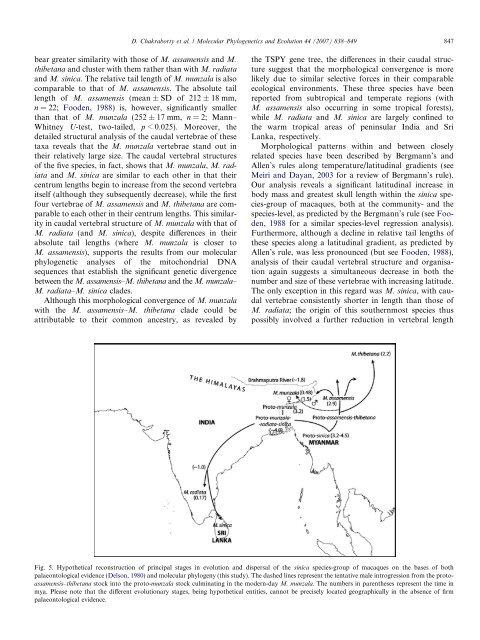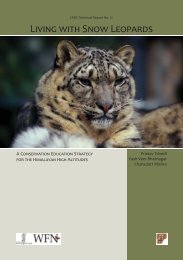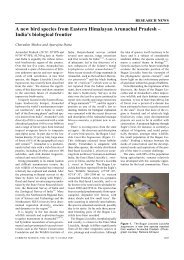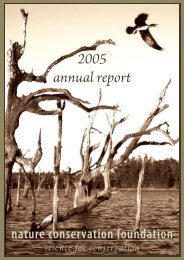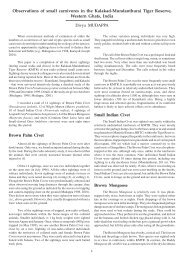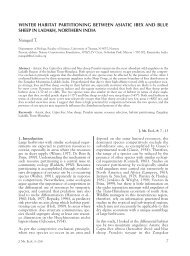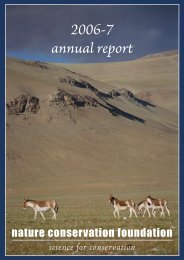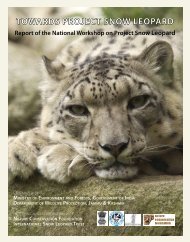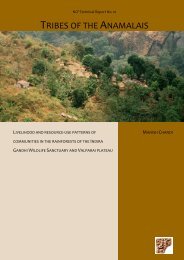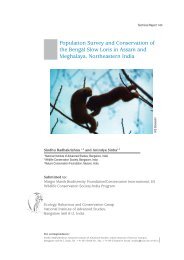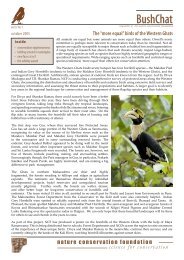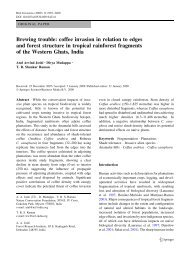Macaca munzala - Nature Conservation Foundation
Macaca munzala - Nature Conservation Foundation
Macaca munzala - Nature Conservation Foundation
Create successful ePaper yourself
Turn your PDF publications into a flip-book with our unique Google optimized e-Paper software.
D. Chakraborty et al. / Molecular Phylogenetics and Evolution 44 (2007) 838–849 847<br />
bear greater similarity with those of M. assamensis and M.<br />
thibetana and cluster with them rather than with M. radiata<br />
and M. sinica. The relative tail length of M. <strong>munzala</strong> is also<br />
comparable to that of M. assamensis. The absolute tail<br />
length of M. assamensis (mean ± SD of 212 ± 18 mm,<br />
n = 22; Fooden, 1988) is, however, significantly smaller<br />
than that of M. <strong>munzala</strong> (252 ± 17 mm, n = 2; Mann–<br />
Whitney U-test, two-tailed, p < 0.025). Moreover, the<br />
detailed structural analysis of the caudal vertebrae of these<br />
taxa reveals that the M. <strong>munzala</strong> vertebrae stand out in<br />
their relatively large size. The caudal vertebral structures<br />
of the five species, in fact, shows that M. <strong>munzala</strong>, M. radiata<br />
and M. sinica are similar to each other in that their<br />
centrum lengths begin to increase from the second vertebra<br />
itself (although they subsequently decrease), while the first<br />
four vertebrae of M. assamensis and M. thibetana are comparable<br />
to each other in their centrum lengths. This similarity<br />
in caudal vertebral structure of M. <strong>munzala</strong> with that of<br />
M. radiata (and M. sinica), despite differences in their<br />
absolute tail lengths (where M. <strong>munzala</strong> is closer to<br />
M. assamensis), supports the results from our molecular<br />
phylogenetic analyses of the mitochondrial DNA<br />
sequences that establish the significant genetic divergence<br />
between the M. assamensis–M. thibetana and the M. <strong>munzala</strong>–<br />
M. radiata–M. sinica clades.<br />
Although this morphological convergence of M. <strong>munzala</strong><br />
with the M. assamensis–M. thibetana clade could be<br />
attributable to their common ancestry, as revealed by<br />
the TSPY gene tree, the differences in their caudal structure<br />
suggest that the morphological convergence is more<br />
likely due to similar selective forces in their comparable<br />
ecological environments. These three species have been<br />
reported from subtropical and temperate regions (with<br />
M. assamensis also occurring in some tropical forests),<br />
while M. radiata and M. sinica are largely confined to<br />
the warm tropical areas of peninsular India and Sri<br />
Lanka, respectively.<br />
Morphological patterns within and between closely<br />
related species have been described by Bergmann’s and<br />
Allen’s rules along temperature/latitudinal gradients (see<br />
Meiri and Dayan, 2003 for a review of Bergmann’s rule).<br />
Our analysis reveals a significant latitudinal increase in<br />
body mass and greatest skull length within the sinica species-group<br />
of macaques, both at the community- and the<br />
species-level, as predicted by the Bergmann’s rule (see Fooden,<br />
1988 for a similar species-level regression analysis).<br />
Furthermore, although a decline in relative tail lengths of<br />
these species along a latitudinal gradient, as predicted by<br />
Allen’s rule, was less pronounced (but see Fooden, 1988),<br />
analysis of their caudal vertebral structure and organisation<br />
again suggests a simultaneous decrease in both the<br />
number and size of these vertebrae with increasing latitude.<br />
The only exception in this regard was M. sinica, with caudal<br />
vertebrae consistently shorter in length than those of<br />
M. radiata; the origin of this southernmost species thus<br />
possibly involved a further reduction in vertebral length<br />
Fig. 5. Hypothetical reconstruction of principal stages in evolution and dispersal of the sinica species-group of macaques on the bases of both<br />
palaeontological evidence (Delson, 1980) and molecular phylogeny (this study). The dashed lines represent the tentative male introgression from the protoassamensis–thibetana<br />
stock into the proto-<strong>munzala</strong> stock culminating in the modern-day M. <strong>munzala</strong>. The numbers in parentheses represent the time in<br />
mya. Please note that the different evolutionary stages, being hypothetical entities, cannot be precisely located geographically in the absence of firm<br />
palaeontological evidence.


